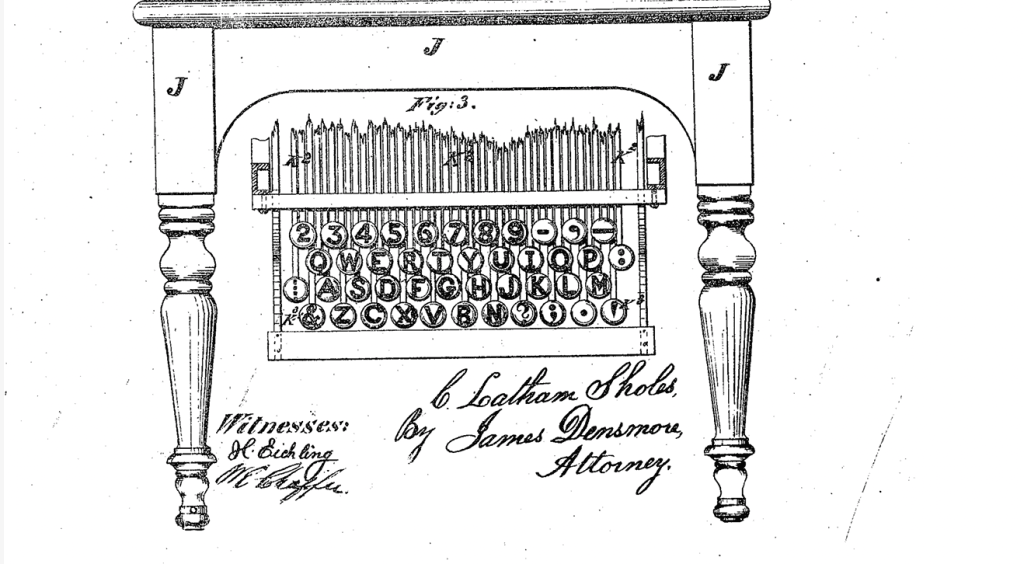It is a common belief that when printing quickly, the hammers responsible for adjacent letters interlocked. The most common layout today was invented to prevent this. We decided to check if this is true.
This version of the invention of the QWERTY layout can be found on resourcesdedicated to computer technologies, on thematic forums, educational And entertaining Internet-portals, in glossy magazines, in blogs on "Zene", "Habré" and in "LiveJournal" Users also write about this social networks.
The QWERTY keyboard layout, named after the first keys of the top row, is currently the most common standard for devices in countries that use the English alphabet. It was developed in the early 1870s Christopher Sholes, an American publisher and amateur inventor who stood at the origins creation and distribution of typewriters.
Initially, the keys on Scholes' typewriters were located in alphabetical order. However, legend says that when adjacent keys were pressed quickly, the hammers, which were responsible for imprinting the letters on the paper, stuck together, the typewriter jammed and the printing process had to be stopped. Allegedly, it was precisely to prevent such situations that Sholes developed the QWERTY layout, placing frequently occurring letter combinations further away from each other.
However, if we compare the most popular letter combinations in the English language with the arrangement of letters on the keyboard, you can notice that, for example, the letters R and E (and their combinations RE and ER are one of the most common) are still located next to each other. And the letters from the most popular combination - TH - are quite close to each other. At the same time, on one of prototypes Scholes' typewriter, there should have been a dot in place of the letter R, so this proximity could have been avoided. But in the end, it was the machine with the familiar arrangement of letters that went into mass production. If the goal was to spread common characters as far apart as possible, why make an exception for some of them? In addition, in the text of the description of the invention in patent There's no word on whether the QWERTY layout helps reduce typing jams. And if this were the case, such a competitive advantage would be worth mentioning in the first place.

In addition, later, having already sold the rights to his invention to Remington, Sholes continued to improve the device and in 1896 received patent to a typewriter, where a completely different layout was presented. However, even there some frequently occurring combinations of letters (for example, N and T) were located nearby. This means that Scholes was not further guided by the idea of spacing frequent combinations as far apart as possible.
Another popular one version The appearance of the now familiar arrangement of letters is that the letters needed to type the word typewriter (“typewriter” - English) are in the top row. This supposedly allowed salespeople to type the word at lightning speed, capturing the imagination of buyers, which in turn increased sales. However, neither we nor other researchers were able to find historical evidence that would confirm this version.
Another common one theory The popularity of the QWERTY layout says that the Remington company, which produced such typewriters, also opened typist courses, where they taught fast typing. Thus, companies that needed typing services were forced to purchase such machines, since specialists were best able to type on them. Perhaps the letters on the keyboard were deliberately arranged in a non-obvious way, so that in order to master fast typing it was necessary to take courses. This created a kind of vicious circle: in order to master printing on such machines, you had to graduate from a special school, and after graduating, it was most convenient to work on machines with such a layout. And all the profits - from courses and sales of cars - were received by Remington.
Historian Ian Noyes from Loughborough University (UK) back in 1983 studied documents related to the invention of the QWERTY layout, reviewed all existing versions and came to conclusionthat there is simply no obvious reason for the placement of letters on the keyboard in this particular way.
In 2011, researchers from Kyoto University (Japan) nominated another theory why the letters on a QWERTY keyboard are arranged this way. The fact is that at the end of the 19th century, typewriters were often used to decipher messages transmitted via telegraph using Morse code. So, for example, in American Morse code Z is denoted "· · · ·" and was often confused with SE (S was denoted "· · ·" and E was denoted "·"). Telegraph operators often could not determine whether to use Z or SE until they received the next letters. In the QWERTY layout, unlike the alphabetic layout, these letters are located close to each other, which allowed the telegraph operator to quickly type the necessary letters as soon as he understood which one was required. Japanese scientists also consider the version of an attempt to prevent the mechanism from jamming when quickly pressing adjacent letters to be unlikely.
Thus, there is not a single piece of evidence that would confirm that the reason for this particular arrangement of letters on the QWERTY keyboard was an attempt to prevent the hammers from jamming on adjacent letters. Moreover, if this were the case, inventors would certainly have mentioned it in the description of their product when obtaining a patent. Some frequently occurring combinations in the English language are still quite close to each other, which partially refutes the theory in question. There are several other versions of why the letters were arranged in this particular way, but none of them have yet been confirmed for sure.
Most likely not true
Read on the topic:
- Is it true that Henry Ford invented the assembly line?
- Is it true that the inventor of sugar packets hanged himself after seeing them being opened incorrectly?
- Is it true that the inventor invented a revolving door to avoid holding the door open for women?
- Is it true that chips were invented thanks to multimillionaire Vanderbilt?
If you find a spelling or grammatical error, please let us know by highlighting the error text and clicking Ctrl+Enter.






